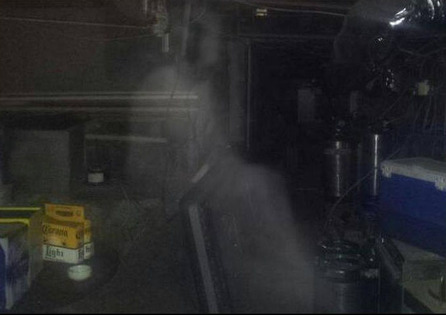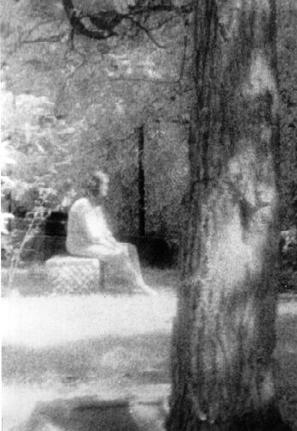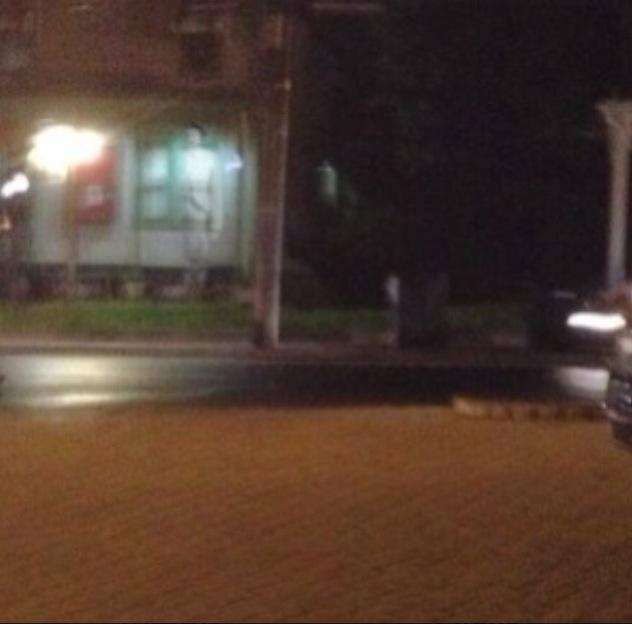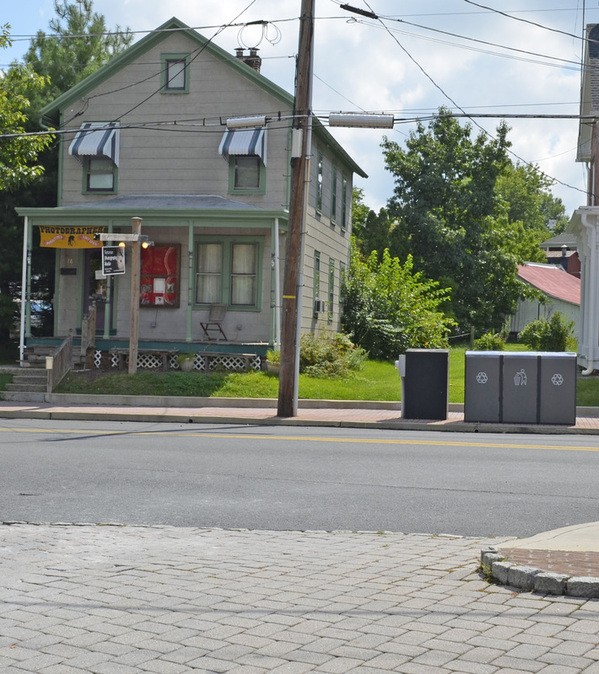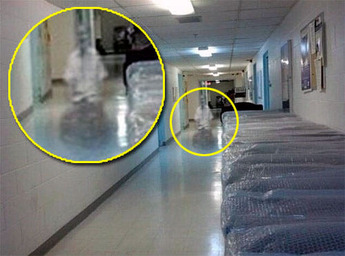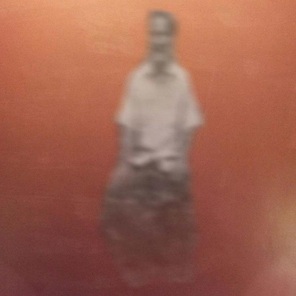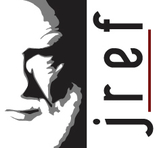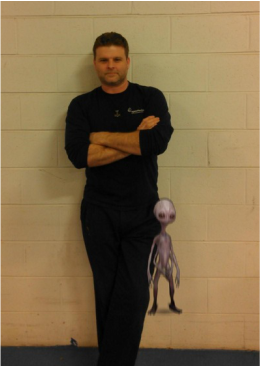
Here is another piece on paranormal photo investigation by Kenny Biddle. Elementary and middle school educators will be interested in this piece as an example of how to think about possible hoax photographs and developing a protocol for examining and investigating extraordinary claims.
By Kenny Biddle
“Ghost Cam Apps” are smart phone applications that place fabricated images of ghosts, aliens, and monsters in actual pictures. There have been cases in which a group or individual attempted to pass off an image from a ghost app as a genuine ghost – even using a “ghost” that is extremely well-known throughout the paranormal community.
Smartphones – they have become an essential part of many of our everyday lives, as much as the keys to our home and vehicle, our wallets or our purses. Their big claim to fame, besides processing power, is the almighty “app”. For the paranormal enthusiast, there’s an overabundance of “ghost hunting” related apps - from ghost cameras that offer a gallery of “ghosts” you can insert into any image, a “radar” that supposedly scans the area and pinpoints otherworldly entities, and even random word generators that supposedly interpret messages from spirits (no, they do not). Currently, there are well over 250 ghost related apps available for Android-based phones available for free or up to $4.99.
Based on the number of hoaxed images circulating on the internet, ghost apps “ghost cameras” are popular. Like other apps in this category, “ghost cams” (as they’re popularly known) make use of your phone’s camera and a gallery of images containing ghosts, aliens, monsters, soldiers, kids, demons, and so on. You snap a picture as you normally would, then are given the option of choosing an entity to insert into the image. You are also given customizing options such as where to place the ghost, rotating it, flipping it, adjusting transparency, and even the ability to erase parts of the ghost! Unsuspecting friends and family unfamiliar with ghost cams, photography, or some of the more famous ghostly images in the history of paranormal investigation can easily be fooled. Hoaxed images are presented with false sincerity by the hoaxer. And make no mistake; these are deliberate actions to deceive.
By Kenny Biddle
“Ghost Cam Apps” are smart phone applications that place fabricated images of ghosts, aliens, and monsters in actual pictures. There have been cases in which a group or individual attempted to pass off an image from a ghost app as a genuine ghost – even using a “ghost” that is extremely well-known throughout the paranormal community.
Smartphones – they have become an essential part of many of our everyday lives, as much as the keys to our home and vehicle, our wallets or our purses. Their big claim to fame, besides processing power, is the almighty “app”. For the paranormal enthusiast, there’s an overabundance of “ghost hunting” related apps - from ghost cameras that offer a gallery of “ghosts” you can insert into any image, a “radar” that supposedly scans the area and pinpoints otherworldly entities, and even random word generators that supposedly interpret messages from spirits (no, they do not). Currently, there are well over 250 ghost related apps available for Android-based phones available for free or up to $4.99.
Based on the number of hoaxed images circulating on the internet, ghost apps “ghost cameras” are popular. Like other apps in this category, “ghost cams” (as they’re popularly known) make use of your phone’s camera and a gallery of images containing ghosts, aliens, monsters, soldiers, kids, demons, and so on. You snap a picture as you normally would, then are given the option of choosing an entity to insert into the image. You are also given customizing options such as where to place the ghost, rotating it, flipping it, adjusting transparency, and even the ability to erase parts of the ghost! Unsuspecting friends and family unfamiliar with ghost cams, photography, or some of the more famous ghostly images in the history of paranormal investigation can easily be fooled. Hoaxed images are presented with false sincerity by the hoaxer. And make no mistake; these are deliberate actions to deceive.
Probably the most popular ghost app is GhostCam: Spirit Photography® by Thepparit Insa, which appears at the top of the list when searching the Google Pay Store. While reading the description, it plainly states “Prank and fool your friends easily with mockup haunted photo”, which it does quite well. It seems that it also fools many paranormal enthusiasts. For one case in particular, this ghost camera phone app was used to perpetuate a hoax – not one for fun, but a hoax for popularity and publicity.
The Holy Grail of Hoaxes (1)
The story of this hoax was documented in the September 2012 issue of The Bent Spoon magazine, written by Jason Korbus (2):
The Holy Grail of Hoaxes (1)
The story of this hoax was documented in the September 2012 issue of The Bent Spoon magazine, written by Jason Korbus (2):
“There is a paranormal group that goes by the name of Ghosts of New England Research Society (G.O.N.E.R.S, for short). Recently, they began publicizing a hoaxed ghost photo as authentic. They have also been using the hoax, in part, to promote an episode of the Discovery Channel series “American Haunting” that they’ll be featured on this fall.
Understandably, this has gotten a number of people in the paranormal community up in arms. Fraudulent ghost photos are something most investigators decry and, indeed, it was skeptical paranormal investigators themselves who spotted the fraud in the first place.
The photo, taken at Ryder’s on Main, a bar and restaurant in Meridan, CT shows the hazy silhouette of what G.O.N.E.R.S calls “The Holy Grail of Paranormal Research: A Full Body apparition of what appears to be a woman in 1920s-30s period attire…” Of course, anyone familiar with famous ghost photos recognized this image as the well-documented “Madonna of Bachelor’s Grove” taken at the Chicago cemetery by members of the Ghost Research Society in the summer of 1991. It had simply been superimposed on a photo taken inside Ryder’s on Main by way of Photoshop or perhaps even a smartphone app.
Skeptical paranormal investigator Kenny Biddle who, in full disclosure, must also be noted as a contributor to The Bent Spoon, first spotted the forgery on Facebook, drawing attention to the striking similarities between the images and quickly swayed opinion. While many on the thread were originally hyping it up as a great piece of evidence, they soon turned to castigating the paranormal team in question for using it to market themselves.
The story soon went viral and Ghosts of New England Research Society took the image down, apparently not commenting publicly on the matter.
In defense of G.O.N.E.R.S, it is unclear whether they hoaxed the photo themselves, or were duped by the bar/restaurant. Either way, however, the paranormal team is culpable. They should have known how famous the Bachelor’s Grove image is, for one. Secondly, they should not have publicized and promoted the photo from Ryder’s on Main to get attention for their upcoming television exposure.”
I had contacted the owner of the restaurant and was informed that she had taken the image herself with a smartphone, and had sent it via text to the paranormal group. However, she stated that the “ghost” was not in the image she sent (3). Unfortunately, as reported by Jason Korbus, we still don’t know who added the ghost, since neither party admitted to perpetrating the hoax – yet, there is no mistake that this was indeed a hoax. The original image that was used to create this hoax is entitled “The Madonna of Bachelor’s Grove”, and was taken by Jude Huff-Felz (4), and has appeared in numerous books and on hundreds (if not thousands) of websites. It’s safe to say it is well-known, and should have been recognized by any “experienced” paranormal group.
Below is series of images that starts with the hoaxed image, and then is overlayed with the image of the Madonna of Bachelor’s Grove with varying transparencies. This demonstrates that the images are from the same source.
Below is series of images that starts with the hoaxed image, and then is overlayed with the image of the Madonna of Bachelor’s Grove with varying transparencies. This demonstrates that the images are from the same source.
At the time of this incident, the GhostCam: Spirit Photography app featured a drop-in version of the Madonna of Bachelor’s Grove – without permission from the owner of the image. I had contacted Dale Kaczmarek of the Ghost Research Society about this matter, and they in turn contacted the app company. The Madonna of Bachelor’s Grove image was removed with the next update of the app.
This incident demonstrates just how easily some ghost hunting groups could be fooled with an app meant to be nothing more than a prank. A group that promoted themselves as “a hauntings/paranormal research team composed of some of the most experienced investigators in the field today” (5), failed to recognize one of the most famous images in the history of the paranormal. If they can be fooled, how do you think someone not so familiar with the paranormal will fare? Perhaps some paranormal groups should focus less on getting on TV, and more on actually learning about what they claim to be doing (i.e. investigating).
A Spooky Ghost in Gettysburg
It’s not only greed or popularity that’s behind perpetuating a hoax, sometimes it’s simply to prank someone, even a ghost hunter. The problem escalates when a paranormal group then promotes such an image as “the real deal” without ever bothering to research/investigate the images before posting it to promote themselves. In this next case, the prank fooled yet another paranormal group, who in turn promoted the hell out of it. Angela Sangster (from Paranormal In Review) tells the story (6).
This incident demonstrates just how easily some ghost hunting groups could be fooled with an app meant to be nothing more than a prank. A group that promoted themselves as “a hauntings/paranormal research team composed of some of the most experienced investigators in the field today” (5), failed to recognize one of the most famous images in the history of the paranormal. If they can be fooled, how do you think someone not so familiar with the paranormal will fare? Perhaps some paranormal groups should focus less on getting on TV, and more on actually learning about what they claim to be doing (i.e. investigating).
A Spooky Ghost in Gettysburg
It’s not only greed or popularity that’s behind perpetuating a hoax, sometimes it’s simply to prank someone, even a ghost hunter. The problem escalates when a paranormal group then promotes such an image as “the real deal” without ever bothering to research/investigate the images before posting it to promote themselves. In this next case, the prank fooled yet another paranormal group, who in turn promoted the hell out of it. Angela Sangster (from Paranormal In Review) tells the story (6).
“Recently, a tour for a well-known location had a picture on their Facebook page that was identified as one of the dreaded "ghost apps" by Tkay (Anderson). The picture had been taken by a guest on the tour and the page posted it as "the real deal!" We were glad to see a few step-up and voice their suspicions that the tour managers had been bamboozled by a fake. A friend to this page, Kenny Biddle, stepped in with an extremely well-versed comment that was removed as soon as the page saw it.
And thus--the backtracking boogie began with the administrators of the page claiming that their words had been misconstrued, the person who took the photo was a ten-year-old child and everyone calling it fake were mean, terrible people for accusing a kid of lying. The topper--an oldie but goodie--"why are you taking this so seriously? Get a life!" The picture, along with all of the comments, was deleted and the page went on like nothing ever happened.
We know there are many who would argue that ghost tours by their very definition are entertainment and therefore not subject to the same scrutiny as other claims. However we are seeing that the tours have gone from enjoyable history/mystery walks to high priced over-hyped bullshit that is often promoted by paranormal "research" teams.
It's never acceptable to claim fake or explainable pictures as the real deal. It's even worse when it is done to justify the prices and outright false histories being promoted by some of the locations. When we searched an online ghost tour directory for the United States, we discovered more than 400 tours listed. There's no doubt about it...ghosts make bank.”
Not only was the specific app identified, but the specific “ghost” in this case was identified by Tkay Anderson, co-founder of “There’s a (ghost) App For That” Facebook page. Thanks to her quick research, we learned the phone app used in this case is called “Ghost Camera Prank - Fun Addictive Photobomb App” by Funny Photo Remix LTD.
This particular paranormal group runs a tour out of Gettysburg, Pa and promotes themselves as a “professional team” with “experienced staff”. Yet, they accepted a “ghost” photo that, according to them, came from a 10-year old (unverified) at face-value, without any attempt to research and validate the image. This demonstrates a serious lack of investigative skill, experience and professionalism.
However, let’s have a closer look. Set aside the knowledge that it’s a phone app and take a look at the image. What details stand out that tell us that this image is not a legitimate photograph of a ghost?
However, let’s have a closer look. Set aside the knowledge that it’s a phone app and take a look at the image. What details stand out that tell us that this image is not a legitimate photograph of a ghost?
The image is in color – except for the “ghost” causing it to stand out in the image. This was the first clue that it was a fake.
Another detail that stands out was how sharp the image of the ghost was compared to the rest of the image. The image appears a bit fuzzy due to camera shake, which means the camera moved as it was actively capturing the image - no flash was used, causing the camera to adjust the shutter speed slower than normal. Even though the image suffers from this, the “ghost” remains unaffected. These two flaws alone are enough to conclude that this image was created, rather than captured. But wait, there’s more!
The building in the image is the Victorian Photography Studio, located in Gettysburg, Pa. The image of the “ghost” appears to be huge, “standing” on the porch of the building. If I was pressed to guess, I would say he had to be around ten feet tall. However, this was just my estimation, and when presenting evidence why an image is a hoax, you have to be sure. So, I visited the location with my camera and a measuring tape in order to get a proper measurement of the height of the porch. (I stress the importance of going to the site.) The porch height is 119 inches (9 feet, 11 inches). The “ghost” in this image is missing his legs below the knees, which we might estimate to be an additional foot (based on my own leg from below the knee to the floor). The ghost stretches from floor to porch roof. Add in the missing lower legs and we have approximately an eleven foot tall ghost.
11 foot tall, black and white in a color image, remains in sharp focus despite motion blur affecting everything else in the image. We can soundly conclude this ghost is an insert into the original image. Case closed.
Another detail that stands out was how sharp the image of the ghost was compared to the rest of the image. The image appears a bit fuzzy due to camera shake, which means the camera moved as it was actively capturing the image - no flash was used, causing the camera to adjust the shutter speed slower than normal. Even though the image suffers from this, the “ghost” remains unaffected. These two flaws alone are enough to conclude that this image was created, rather than captured. But wait, there’s more!
The building in the image is the Victorian Photography Studio, located in Gettysburg, Pa. The image of the “ghost” appears to be huge, “standing” on the porch of the building. If I was pressed to guess, I would say he had to be around ten feet tall. However, this was just my estimation, and when presenting evidence why an image is a hoax, you have to be sure. So, I visited the location with my camera and a measuring tape in order to get a proper measurement of the height of the porch. (I stress the importance of going to the site.) The porch height is 119 inches (9 feet, 11 inches). The “ghost” in this image is missing his legs below the knees, which we might estimate to be an additional foot (based on my own leg from below the knee to the floor). The ghost stretches from floor to porch roof. Add in the missing lower legs and we have approximately an eleven foot tall ghost.
11 foot tall, black and white in a color image, remains in sharp focus despite motion blur affecting everything else in the image. We can soundly conclude this ghost is an insert into the original image. Case closed.
| Examples of media outlets published app photos as "news" Shadowy photo called “baby ghost” in Cheltenham Gaggles of ghost photos make us gag Perfectly strange: Red lights seen in WA neighborhood Come on, local news teams! Falling for hoaxed UFO photos? Lame |
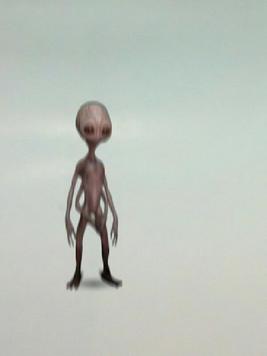
Close Encounters of the App Kind…
The last case takes us off the path of ghosts and spirits, and delves into aliens. I work with many members of the MUFON, the Mutual UFO Network and receive all kinds of images (from the eastern U.S.) with claims of UFOs or “orbs”. In most cases, I’ve been able to find natural causes for the unidentified flying objects. Once in a while, I just do not have enough information to understand what was recorded, and I must do what I can to obtain the necessary information or end up filing it under the heading “I don’t know”. And then, once in a while, I get an image that makes me think “Are you serious?!”
About two years ago I received an email with an attached image, asking me to review it as quickly as possible. In order to avoid any influence from what the sender thinks they have captured, I bypass the information provided and look at the image first. When I opened the image, my jaw dropped – it was that bad.
It was a winter scene, with a view of snow covered trees that encompassed the entire image. On the left side, floating in mid-air was a short alien humanoid with four arms. He was blurry, as if he was vibrating or in motion. The humanoid figure also appeared as fake as the effects on any low budget science fiction movie (Unfortunately, I was unable to obtain permission to reproduce the image).
According to the witness who took the image, she saw this alien looking in the through the glass doors of her deck. It was hovering approximate ten feet off the ground and fifteen feet out away. The witness also stated that a week before taking this image, she saw a small humanoid floating and moving very quickly through the woods behind her home.
The image was to be included in a major book that was ready to be published, and was going to be a feature of a very popular radio program that focused on Ufology. All that was needed was an analysis from a photographer, verifying the image was authentic. And so the image was now before me…
I knew it was a hoax, created by yet another phone app but I did not know which one. The alien had a cartoon look to it, like something out of a video game. The image of the alien itself was pixelated, meaning that it was enlarged so far that the viewer begins to see the individual pixels that form the image.
The break in pinning down the source came from an unlikely source, a co-worker who asked what I was working on. When I showed him the image he said “Oh, I know that one!” He whipped out his phone, opened an app and took a picture – and there was the very same alien.
The phone app used was called Camera 360 Ultimate, created by Pingo Inc. (7) In 2012, there was an update that added UFOs, E.T.s and lightning effects. I informed the MUFON investigators of the hoax, and they immediately checked and found the fake alien themselves. They were very grateful, avoiding what would have been an embarrassing experience.
The Famous Little Girl
In addition to the three cases presented here, which I was personally involved in, there are a few other popular “ghosts” that continually make the internet rounds. I’ll present them here, so that you may save time that would be otherwise wasted finding out if these were real or fake. Amaze your friends with your debunking knowledge.
First up, she is arguably the most popular ghost app “ghost” (girl) on the internet. This little girl first appeared in a photo taken in a hospital room, which had gained over 9,000 shares on Facebook. She has since appeared near train tracks, on a few stair cases, in kitchens, hallways, private homes, by a deer feeder and even in bathroom selfies. This little ghost was part of an app called "Ghost Capture" by – get this – a company by the name of Ghosts Don't Exist (8). It’s available for the iPhone for the bargain price of $0.99.
The last case takes us off the path of ghosts and spirits, and delves into aliens. I work with many members of the MUFON, the Mutual UFO Network and receive all kinds of images (from the eastern U.S.) with claims of UFOs or “orbs”. In most cases, I’ve been able to find natural causes for the unidentified flying objects. Once in a while, I just do not have enough information to understand what was recorded, and I must do what I can to obtain the necessary information or end up filing it under the heading “I don’t know”. And then, once in a while, I get an image that makes me think “Are you serious?!”
About two years ago I received an email with an attached image, asking me to review it as quickly as possible. In order to avoid any influence from what the sender thinks they have captured, I bypass the information provided and look at the image first. When I opened the image, my jaw dropped – it was that bad.
It was a winter scene, with a view of snow covered trees that encompassed the entire image. On the left side, floating in mid-air was a short alien humanoid with four arms. He was blurry, as if he was vibrating or in motion. The humanoid figure also appeared as fake as the effects on any low budget science fiction movie (Unfortunately, I was unable to obtain permission to reproduce the image).
According to the witness who took the image, she saw this alien looking in the through the glass doors of her deck. It was hovering approximate ten feet off the ground and fifteen feet out away. The witness also stated that a week before taking this image, she saw a small humanoid floating and moving very quickly through the woods behind her home.
The image was to be included in a major book that was ready to be published, and was going to be a feature of a very popular radio program that focused on Ufology. All that was needed was an analysis from a photographer, verifying the image was authentic. And so the image was now before me…
I knew it was a hoax, created by yet another phone app but I did not know which one. The alien had a cartoon look to it, like something out of a video game. The image of the alien itself was pixelated, meaning that it was enlarged so far that the viewer begins to see the individual pixels that form the image.
The break in pinning down the source came from an unlikely source, a co-worker who asked what I was working on. When I showed him the image he said “Oh, I know that one!” He whipped out his phone, opened an app and took a picture – and there was the very same alien.
The phone app used was called Camera 360 Ultimate, created by Pingo Inc. (7) In 2012, there was an update that added UFOs, E.T.s and lightning effects. I informed the MUFON investigators of the hoax, and they immediately checked and found the fake alien themselves. They were very grateful, avoiding what would have been an embarrassing experience.
The Famous Little Girl
In addition to the three cases presented here, which I was personally involved in, there are a few other popular “ghosts” that continually make the internet rounds. I’ll present them here, so that you may save time that would be otherwise wasted finding out if these were real or fake. Amaze your friends with your debunking knowledge.
First up, she is arguably the most popular ghost app “ghost” (girl) on the internet. This little girl first appeared in a photo taken in a hospital room, which had gained over 9,000 shares on Facebook. She has since appeared near train tracks, on a few stair cases, in kitchens, hallways, private homes, by a deer feeder and even in bathroom selfies. This little ghost was part of an app called "Ghost Capture" by – get this – a company by the name of Ghosts Don't Exist (8). It’s available for the iPhone for the bargain price of $0.99.
Thanks to the Facebook page “Little Girl Ghost”, an original copy of the image of her was found (the image on the right of the series above) on the website of Family Discovery Genealogy (9). I contacted Anne, owner of the site, and asked her about the image. She replied that she had no idea where the image had come from, that it was randomly pulled off the internet (10). Dropping the original image into Google Images, I found the original appears on About.com, under the category Doll Collecting with the caption “Photo Victorian Girl In Plaid Dress, Early photo” (11). She also appears on a site “Shawano County Birth’s 1908-1924” (12), and as profile image for a Blog on dolls. It even appeared attached to a letter about children being abused by a teacher (13). None of these sites offer any information of who the little girl is. Her true identity remains lost to history.
The Ghost in a Wheelchair
Another popular app ghost has been the “wheelchair ghost”, which first appeared in 2012. A popular version of the story goes something like this:
“This was taken in the basement of Kith Haven Assisted Living in Flint, Michigan on November 23, 2012 by an employee who said she saw it with her eyes, grabbed a phone, and took this picture.
This photo was sent to my friend and co-worker. He received it from his ex-wife. Her cousin took it. She said she was working in the basement of the home and was walking quickly between rooms when she noticed something from the corner of her eye. She stepped back and it was right there — and stayed there — while she took the picture with her phone! She was amazed to see the image in the center of the hall — could not believe it was real!
Everyone can see a man in a white shirt, possibly in a wheel chair, but look again: I see a man pushing a woman with her arms crossed over her chest. I can see her face turned to the right. Could it be this caregiver is still on the job?” (14)
The Ghost in a Wheelchair
Another popular app ghost has been the “wheelchair ghost”, which first appeared in 2012. A popular version of the story goes something like this:
“This was taken in the basement of Kith Haven Assisted Living in Flint, Michigan on November 23, 2012 by an employee who said she saw it with her eyes, grabbed a phone, and took this picture.
This photo was sent to my friend and co-worker. He received it from his ex-wife. Her cousin took it. She said she was working in the basement of the home and was walking quickly between rooms when she noticed something from the corner of her eye. She stepped back and it was right there — and stayed there — while she took the picture with her phone! She was amazed to see the image in the center of the hall — could not believe it was real!
Everyone can see a man in a white shirt, possibly in a wheel chair, but look again: I see a man pushing a woman with her arms crossed over her chest. I can see her face turned to the right. Could it be this caregiver is still on the job?” (14)
This ghost was (and still is) included in the previously mentioned app, GhostCam: Spirit Photography. Although this guy didn’t get around to different locations, as the little girl previously mentioned, this solitary image was shared on social media over 4,000 times. Many sites, like the one quoted above, still have this image listed as an “unexplained”. This is despite a solid explanation being available for as long as the photo has been circulating.
Wrapping it Up
Ghost apps are out there by the hundreds, and have been a common problem for a few years now. Consulting sites like the Facebook pages “There’s a (Ghost) App For That” and “Ghost App Ghosts” has become a regular practice, being one of the few ways to properly combat such deceptions. Ghost apps have become such a common source that when looking at alleged paranormal photographs, focus has shifted slightly from “IS that a ghost app picture?” to “Which ghost app was this from?”
Unraveling hoaxes is a huge, time-consuming affair - much greater than the time it takes to generate and publicize the hoax. Those who present these images as genuine show no desire to get to the truth of the matter – be it from taking the image at face-value or having full knowledge of it being a hoax. In a desperate attempt to save their credibility, they demand proof employing the logical fallacy of “Shifting the Burden of Proof” rather than providing evidence to support their claim that the photograph is genuine. If we don’t, they continue to promote false evidence to the public. So, I (and others like me) work overtime to clean up their mess.
With all the ghost apps available, it’s extremely hard to keep track of them all (many of them continue to update, changing out the “ghosts” every few months). If it looks too good to be true, it probably is. The paranormal community is filled with hoaxes, frauds, and way too many people who pretend to know what they’re doing - you can’t take anything presented as evidence at face-value.
Look into it…
Research it…
And confirm (or debunk) it.
References
1. Paranormal in Review, by Angela & Tkay http://paranormalinreview2.zohosites.com/g-o-n-e-r-s.html
2. Korbus, Jason. 2012. “A Picture of Paranormal Fraud”. The Bent Spoon magazine
3. Phone interview with Lynn Ryder.
4. Image Credit Huff-Felz, Jude. “Madonna of Bachelor’s Grove”, Ghost Research Society. August 10, 1991.
5. Ghosts Of New England Research Society. Facebook page. https://www.facebook.com/ghostsofnewengland/info
6. Paranormal in Review website. “Next Stop--Bullshit! Today's "Ghost" Tours” http://paranormalinreview2.zohosites.com/todays-ghost-tours.html
7. “Vibrating Alien” Copyright - Pingo Inc.
8. Ghost Capture on the Apple Store https://itunes.apple.com/us/app/ghost-capture/id349479650?mt=8
9. Family Discovery Genealogy http://www.it-department.co.uk/familydiscovery/restoration.html
10. Email correspondence with Anne Batty of Family Discovery Genealogy.
11. About.Com – Doll Collecting http://collectdolls.about.com/library/clip/blclipimg63.htm
12. Shawano County Birth’s 1908-1924 http://www.rootsweb.ancestry.com/~wishawa4/Births%201908%20Up/Br.htm
13. Letter to Dr. Barnado http://raggedk5group2.pbworks.com/w/page/8194980/Children
14. ScatterJaw. “Wheelchair ghost” http://www.scatterjaw.com/images/tulip-staircase/oakwood-cemetery/wheelchair-ghost/
Research Sources
“There’s A (ghost) App For That” https://www.facebook.com/groups/463476777004091/
Ghost App Ghosts https://www.facebook.com/GhostAppGhosts
Editors Note: http://bustthatghost.com/ is looking for volunteers to help build their ghost image database. Go to their site and click “Help us Out” to help.
Wrapping it Up
Ghost apps are out there by the hundreds, and have been a common problem for a few years now. Consulting sites like the Facebook pages “There’s a (Ghost) App For That” and “Ghost App Ghosts” has become a regular practice, being one of the few ways to properly combat such deceptions. Ghost apps have become such a common source that when looking at alleged paranormal photographs, focus has shifted slightly from “IS that a ghost app picture?” to “Which ghost app was this from?”
Unraveling hoaxes is a huge, time-consuming affair - much greater than the time it takes to generate and publicize the hoax. Those who present these images as genuine show no desire to get to the truth of the matter – be it from taking the image at face-value or having full knowledge of it being a hoax. In a desperate attempt to save their credibility, they demand proof employing the logical fallacy of “Shifting the Burden of Proof” rather than providing evidence to support their claim that the photograph is genuine. If we don’t, they continue to promote false evidence to the public. So, I (and others like me) work overtime to clean up their mess.
With all the ghost apps available, it’s extremely hard to keep track of them all (many of them continue to update, changing out the “ghosts” every few months). If it looks too good to be true, it probably is. The paranormal community is filled with hoaxes, frauds, and way too many people who pretend to know what they’re doing - you can’t take anything presented as evidence at face-value.
Look into it…
Research it…
And confirm (or debunk) it.
References
1. Paranormal in Review, by Angela & Tkay http://paranormalinreview2.zohosites.com/g-o-n-e-r-s.html
2. Korbus, Jason. 2012. “A Picture of Paranormal Fraud”. The Bent Spoon magazine
3. Phone interview with Lynn Ryder.
4. Image Credit Huff-Felz, Jude. “Madonna of Bachelor’s Grove”, Ghost Research Society. August 10, 1991.
5. Ghosts Of New England Research Society. Facebook page. https://www.facebook.com/ghostsofnewengland/info
6. Paranormal in Review website. “Next Stop--Bullshit! Today's "Ghost" Tours” http://paranormalinreview2.zohosites.com/todays-ghost-tours.html
7. “Vibrating Alien” Copyright - Pingo Inc.
8. Ghost Capture on the Apple Store https://itunes.apple.com/us/app/ghost-capture/id349479650?mt=8
9. Family Discovery Genealogy http://www.it-department.co.uk/familydiscovery/restoration.html
10. Email correspondence with Anne Batty of Family Discovery Genealogy.
11. About.Com – Doll Collecting http://collectdolls.about.com/library/clip/blclipimg63.htm
12. Shawano County Birth’s 1908-1924 http://www.rootsweb.ancestry.com/~wishawa4/Births%201908%20Up/Br.htm
13. Letter to Dr. Barnado http://raggedk5group2.pbworks.com/w/page/8194980/Children
14. ScatterJaw. “Wheelchair ghost” http://www.scatterjaw.com/images/tulip-staircase/oakwood-cemetery/wheelchair-ghost/
Research Sources
“There’s A (ghost) App For That” https://www.facebook.com/groups/463476777004091/
Ghost App Ghosts https://www.facebook.com/GhostAppGhosts
Editors Note: http://bustthatghost.com/ is looking for volunteers to help build their ghost image database. Go to their site and click “Help us Out” to help.
Kenny Biddle is a writer, photographer and investigator of paranormal claims. He is a photography consultant for the Mutual UFO Network (MUFON) and gives training and talks on critical thinking and false-positives in paranormal photography. For advice regarding a paranormal claim, contact him through the Anomalies Research Society.

